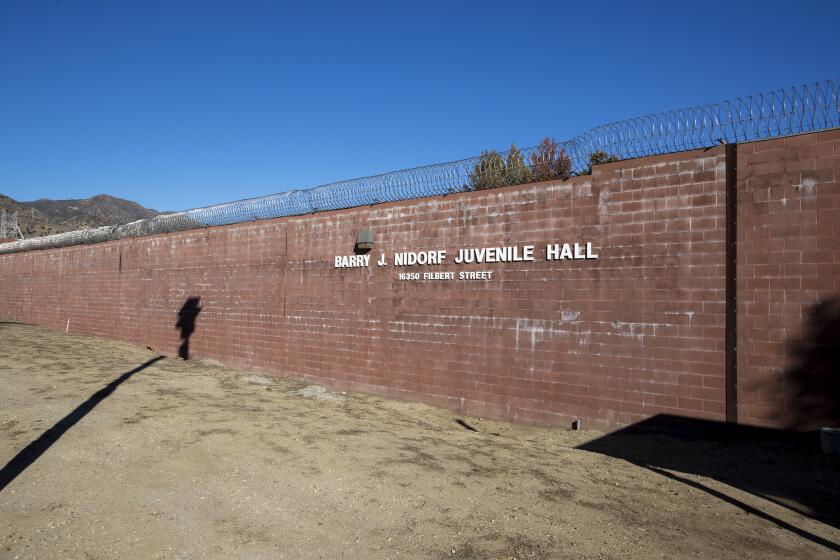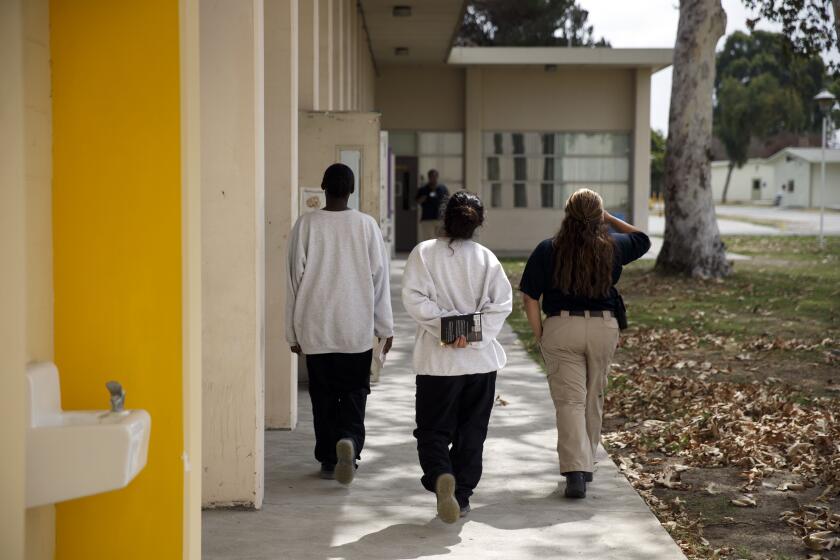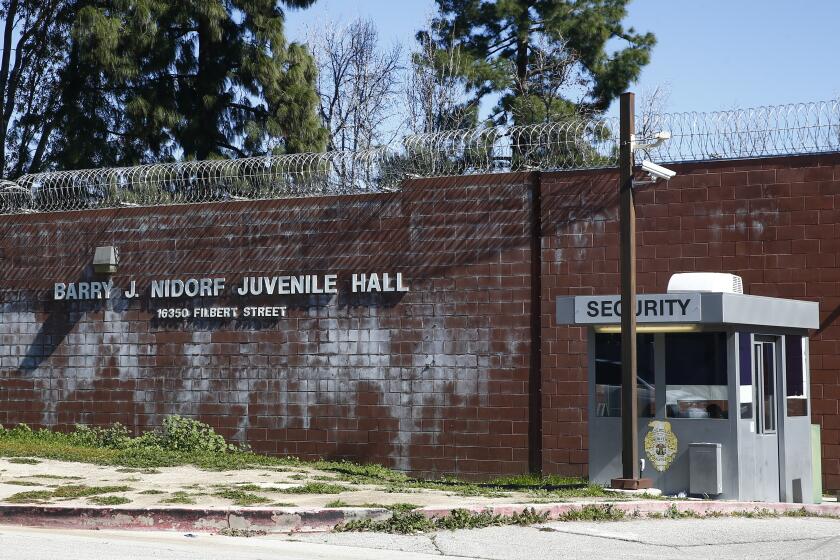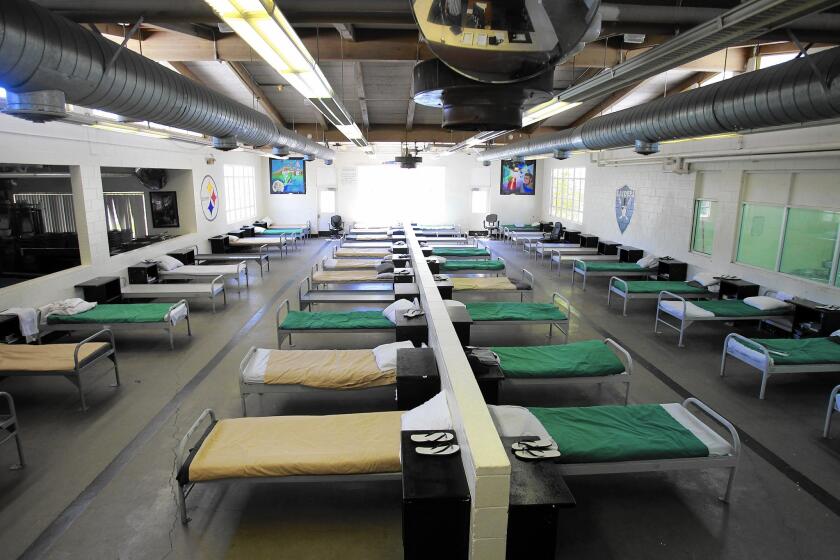Editorial: Among the L.A. Probation Departmentâs many offenses: Hoarding millions in prevention funds

Nearly $100 million in state funding thatâs supposed to be spent on programs to keep Los Angeles County kids out of trouble with the law is instead stuck in the Probation Department, as county lawyers and bureaucrats argue over data reporting requirements.
This is merely a new dimension of an old problem. For at least a decade, money allocated to counties under the Juvenile Justice Crime Prevention Act, signed into law in 2000, trickled too slowly or not at all to L.A. community groups offering approved programs (including tutoring, family counseling, arts, cultural activities and sports) to keep young people out of the juvenile justice system and to help those who have left juvenile halls and probation camps stay out.
Los Angeles County juvenile halls have been cited for unconstitutionally poor conditions for decades. Itâs too late to save them.
At one point, the Probation Department allocated a portion of the funding to itself, for a program known as âvoluntary probation,â in which kids who were not in trouble and not in the juvenile justice system were needlessly put under the departmentâs umbrella anyway, under the supervision of school-based probation officers who provided tutoring and other services outside their expertise. That was legal, but the department was improperly spending the largest portion of voluntary probation funds on salaries for staff who were carrying a caseload, during at least one year, of zero.
Those kinds of shenanigans feed the reasonable suspicion that the Probation Department is actively resisting county policy to diminish the departmentâs role in crime prevention and juvenile rehabilitation. Youth justice advocates and community program providers worry that the department is trying to prevent them from building out an alternative system of community-based mental health, education, peer support and other services that steer young people away from delinquency.
Closing facilities and transferring troubled youths to other buildings will not change the irresponsible management that is endangering and killing people.
It stands to reason that the current failure to spend $99 million (or $92 million, depending on how the money is tabulated) in funding from the crime prevention act would be seen as driven by the departmentâs culture of self-preservation and recalcitrance.
But thereâs also an alternative explanation: The Probation Department and L.A. County administration are lumbering bureaucracies so caught up in details that they sometimes lose sight of their missions.
Half of L.A. County Probation Department juvenile division workers donât come to work, and their unions resist change. The county should push forward and replace the division.
For example, the department insists that it canât distribute money to community organizations for prevention programs until they agree to report personal information about all the kids they serve, in order to measure whether those programs do any good.
Youth advocates say thatâs just like voluntary probation â a way to get more young people onto the departmentâs radar and to stifle âcompetitionâ from organizations offering expertise in health and safety rather than law enforcement.
Troubled young people in care of Los Angeles Countyâs probation department will simply be shuffled among facilities, including the one where a youth recently died of fentanyl poisoning.
And besides, they note, some programs funded by the Juvenile Justice Crime Prevention Act are prohibited by law from reporting data that identify individual youths, especially regarding medical, mental health and substance use and treatment information.
It is true that programs that spend public money have to be evaluated to prevent rip-offs. A 2019 state audit of Juvenile Justice Prevention Act programs called for collecting data on each program participant for precisely this purpose â to determine whether kids in funded programs got into less trouble than other kids â although it did not specify what data to collect.
Itâs time for L.A. County leaders to finally move forward with plans to separate young offenders from adults and impose more effective accountability measures.
Organizations that are required to report on the effectiveness of their programs do so all the time without compiling personal dossiers or violating privacy rights, by removing names and other identifying information, and tracking outcomes anonymously. The Probation Department would be wise to allow community organizations applying for funds to do the same quickly, and get the millions of dollars in piled-up prevention funding out the door without further delay.
Some of the idled money is supposed to go to a program called Ready to Rise, whose goals include helping community-based organizations become self-sustaining. In other words, itâs a government grant that would help wean service providers from government grants. Thatâs not the kind of thing that ought to be slow-walked.
The common denominator is the boardâs micromanagement. Less meddling may well have been part of an effective prescription had it come forward in recent years.
There are other snags. Other county departments that are supposed to direct some of the funds to their own service providers â including the Department of Youth Development and the Department of Arts and Culture â havenât collected it. But the Probation Department could remind other departments to come get their money and spend it on prevention programs.
Of course, the Probation Departmentâs attention has been diverted, to put it mildly. Juvenile halls closed under state order, an old hall was reopened, one juvenile escaped from it (but was quickly returned), a gun was found inside of it, there was a riot and a lockdown. And that was just July.
The systemic problems at the Los Angeles County Probation Departmentâs Juvenile Division will not be solved by merely replacing one more department chief.
The work of the Probation Department can be difficult and dangerous, and the department is not up to the task of managing at-risk juveniles. Many of its problems are of its own making. The failure to spend Juvenile Justice Prevention Act funds is one of them. It should be one of the easier problems to solve.
More to Read
A cure for the common opinion
Get thought-provoking perspectives with our weekly newsletter.
You may occasionally receive promotional content from the Los Angeles Times.

















